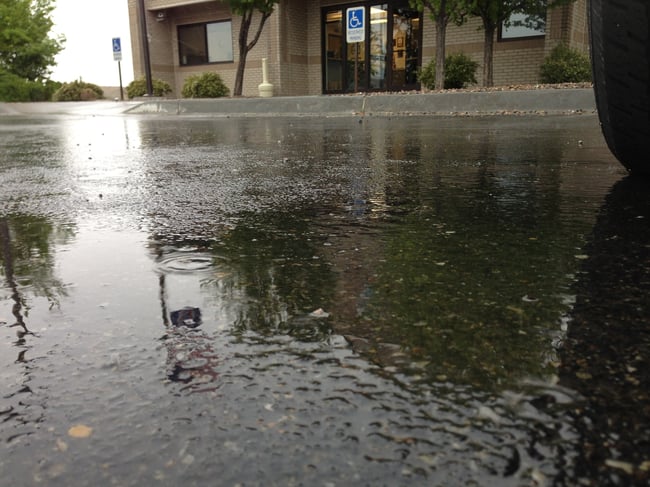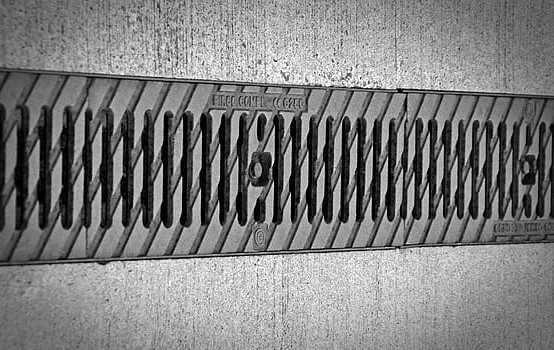Surface water management is a main concern when planning hardscapes. The typically non-porous nature of this type of landscape allows few opportunities for water absorption. This can lead to unsightly pooling of liquid, slip hazards, and even flooding. Because of this, surface water must be carefully managed so it can be redirected, absorbed, or drained offsite.
Trench drains can help solve the issue of surface water management. Sometimes also known as channel drains, trench drains contain a trough or channel-shaped body where water can flow. Usually, a trench drain grate accompanies a trench drain and helps to block debris and make foot traffic easier.
This type of drain is versatile and is able to be used in a variety of situations. Trench drains can manage surface water everywhere from residential homes to parking lots to schools.
 Surface water can become a problem if it is not properly managed.
Surface water can become a problem if it is not properly managed.
Benefits of trench drains
The main function of a trench drain is to protect against flooding and ponding. The channel underneath the grate allows water to flow away from the hardscape to a more suitable drainage location.
The increased drainage derived from a trench drain also provides a number of other benefits. It helps prevent flood damage to nearby buildings by preventing water from pooling up in problem areas. It can also extend the life of paved surfaces by minimizing damage. Because there is less water on the surface, it also reduces the possibility of slip hazards for pedestrians. This in turn extends the usability of the space. Plus, they can also be used in conjunction with other environmentally friendly solutions to reduce human impact on the environment.
 Properly placed drains can reduce the pooling caused by excess surface water.
Properly placed drains can reduce the pooling caused by excess surface water.
The trench drain grate above the channel also serves a functional purpose. It can prevent waste and debris from washing into nearby waterways and from clogging the channel and slowing the drainage process. The grate can also make it easier for vehicles to travel across the channel, as it provides a smooth surface above the drain.
Types of trench drain systems
Trench drains can be used in conjunction with other water management techniques. A properly placed group of trench drains creates an underground system that allows areas to cope with frequent storms. They are also designed and implemented with the impact of water flow on natural waterways in mind.
There are three main types of trench drains to choose from:
- Cast in place trench drains are installed on-site. The channel is dug by hand and the grate is manually installed. This tends to be the most labor-intensive type of trench drain system.
- Precast trench drains are made off-site in separate pieces. These can then be transported to the site, where they are installed.
- Linear trench drains are a modern variation of precast trench drains. These tend to be very narrow and use lightweight materials. A trench is dug and the channel and grate are assembled in the trench. Concrete is then poured around the drain for additional structural support.
Choosing trench drain grates
Since a trench drain system is composed of both the channel and the grate, choosing an appropriate trench drain grate requires some thought.
The main factors to consider include:
- Performance: How much liquid will need to drain at the maximum capacity?
- Loading: How much weight does the grate need to be able to support?
- Durability: How long will it last and what maintenance is required?
- User requirements: What aesthetics and safety features should be considered?
 Trench drain grates need to be able to handle their water management purposes while still providing visual value.
Trench drain grates need to be able to handle their water management purposes while still providing visual value.
Trench drain grates may be visible in the hardscape, so planning for the aesthetics to fit and blend with the rest of the design is important. Jonite trench drain grates are available in a variety of colors and textures to fit with the overall look of the area. They also have different designs, so the grate can either become a focal point of the overall design or blend into the landscape.
Creating a sustainable trench drain system
It’s more important than ever to be climate positive. Even small changes in a hardscape design can impact the sustainability of the area. Trench drain systems can be incorporated as part of a sustainable drainage system (SUD). These types of systems help manage water in a way that aligns with natural water processes. Trench drain systems allow surface water to be managed while reducing harm to the local environment. Trench drains can help prevent water pollution and soil degradation.
In addition, choosing more sustainable trench drain grates can have an impact too. Look for grates that are rust/corrosion resistant and LEED green building certified. These can help reduce the environmental impact of the system.
Final thoughts
Trench drains are a valuable method of surface water management. They allow water to flow through channels that reduce flooding concerns. Choosing an appropriate trench drain system can help meet water management, aesthetic, and sustainability goals in the landscape.










